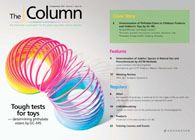Meteor molecules
Researchers have found evidence that some of the building blocks of DNA that have been found in carbon-rich meteorites, may have been created in space and could have provided a molecular kit for the origins of life on Earth

Researchers have found evidence that some of the building blocks of DNA that have been found in carbon-rich meteorites, may have been created in space and could have provided a molecular kit for the origins of life on Earth.All life on Earth depends on DNA and RNA that use pyrimidine and purine nucleobases to encode genetic information. Carbon‑rich meteorites may have been important sources for some of the organic compounds of life on Earth; however, the origin and formation of nucleobases in meteorites has been debated for some time.
A team of NASA-funded researchers investigated the abundance and distribution of nucleobases and nucleobase analogues in formic acid extracts of 12 different meteorites by liquid chromatography–mass spectrometry.1The Murchison and Lonewolf Nunataks 94102 meteorites were found to contain a diverse suite of nucleobases, including three unusual and terrestrially rare nucleobase analogues. These terrestrially rare analogues were not detected above parts-per-billion detection limits in any of the procedural blanks, control samples, a terrestrial soil sample or an Antarctic ice sample.
The study suggests that this supports the idea that the analogues were produced extraterrestrially, with the asteroids producing many variants of the nucleobases, rather than just the commonly occurring biological ones. As part of the study the researchers were also able to demonstrate plausible non-biological mechanisms for their synthesis, further supporting an extraterrestrial origin.
This story originally appeared in The Column. Click here to view that issue.
Detecting Hyper-Fast Chromatographic Peaks Using Ion Mobility Spectrometry
May 6th 2025Ion mobility spectrometers can detect trace compounds quickly, though they can face various issues with detecting certain peaks. University of Hannover scientists created a new system for resolving hyper-fast gas chromatography (GC) peaks.
University of Oklahoma and UC Davis Researchers Probe Lipidomic Profiles with RP-LC–HRMS/MS
May 6th 2025A joint study between the University of Oklahoma Health Sciences Center (Oklahoma City, Oklahoma) and the UC Davis West Coast Metabolomics Center (Davis, California) identified differentially regulated lipids in type 2 diabetes (T2D) and obesity through the application of reversed-phase liquid chromatography-accurate mass tandem mass spectrometry (RP-LC-accurate MS/MS).
Automated Sample Preparation (ISO 20122) for MOSH/MOAH in Seasoning Oils
May 6th 2025This work presents an Automated Sample Preparation procedure for MOSH/MOAH analysis of Seasoning Oils. We compare results from a manual epoxidation procedure compliant with DIN 16995 with results based on fully automated sample preparation (epoxidation and saponification) compliant with ISO 20122. In both cases, online clean-up via activated aluminum oxide (AlOx) are used to remove interfering n-alkanes from the MOSH fraction during the HPLC run. Automated data evaluation using a dedicated software (GERSTEL ChroMOH) is presented.

.png&w=3840&q=75)

.png&w=3840&q=75)



.png&w=3840&q=75)



.png&w=3840&q=75)









